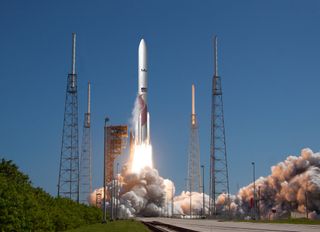Private Dream Chaser Space Plane Will Ride New Vulcan Rocket for NASA Cargo Launches
Dream Chaser and Vulcan will launch six cargo missions to the International Space Station.
The private Dream Chaser space plane has a new ride to the International Space Station.
Sierra Nevada Corp. — the company behind the small, space shuttle-like vessel — announced today (Aug. 14) that it plans to start launching Dream Chaser on the United Launch Alliance's (ULA) new Vulcan Centaur rocket, which is scheduled to launch on its first test flight in 2021.
With the help of the new Vulcan rockets, Sierra Nevada Corp. plans to deliver more than 12,000 lbs. (5,400 kg) of cargo to the space station over the course of six missions beginning in late 2021.
Related: In Pictures: Sierra Nevada's Dream Chaser Aces Glide Test Flight
"I have been a fan and a supporter and a cheerleader of this amazing vehicle from the first moment I saw it," ULA Chief Executive Tory Bruno told reporters as he stood in front of a Dream Chaser test vehicle during a news briefing in Louisville, Colo. "To be able to make Vulcan's commercial debut with this block of missions underneath the Dream Chaser is just truly exciting."
Dream Chaser is about to become the latest addition to the fleet of cargo vessels that NASA uses to launch cargo to the International Space Station. (NASA currently ships cargo to space using a combination of Northrop Grumman's Cygnus spacecraft and SpaceX's Dragon, along with Russia's Progress spacecraft and Japan's HTV cargo ships.)
Although the spacecraft was originally designed to carry humans, Sierra Nevada lost out to SpaceX and Boeing when the company tried to get a contract from NASA to launch astronauts in 2014. Then in 2016, NASA selected Sierra Nevada's Dream Chaser for its Commercial Resupply Services 2 (CRS-2) contract, which involves launching six cargo missions to the space station by 2024.
Get the Space.com Newsletter
Breaking space news, the latest updates on rocket launches, skywatching events and more!




Dream Chaser has been under development since 2004, and it has already completed a few tests. Most recently, in 2017, it completed a free-flight drop test over California's Mojave Desert, after which it aced a landing at Edwards Air Force Base.
Meanwhile, ULA has been developing its next-generation Vulcan Centaur rocket since 2014, and the new launch vehicle is intended to replace the company's workhorse Atlas V rocket. The U.S. Air Force has awarded $967 million for the rocket's development under its National Security Space Launch competition.

In 2017, ULA announced that the first Dream Chaser missions would launch on Atlas V rockets, but the company now aims to use the Vulcan Centaur for all six cargo delivery missions to the space station.
However, the Atlas V could potentially still end up launching the Dream Chaser, Bruno said, but only if the Vulcan Centaur's development is behind schedule. "We're on time with Vulcan," he said, "but if something should arise, we're going to make sure that you fly when you're ready."
- 3 New Rockets Are on Track for 1st Test Flights in 2021
- Vortex Rocket Engine for Private Dream Chaser Space Plane Passes Big Test
- Sierra Nevada Gets NASA Approval for First Dream Chaser ISS Cargo Mission
Email Hanneke Weitering at hweitering@space.com or follow her @hannekescience. Follow us on Twitter @Spacedotcom and on Facebook.
Join our Space Forums to keep talking space on the latest missions, night sky and more! And if you have a news tip, correction or comment, let us know at: community@space.com.

Hanneke Weitering is a multimedia journalist in the Pacific Northwest reporting on the future of aviation at FutureFlight.aero and Aviation International News and was previously the Editor for Spaceflight and Astronomy news here at Space.com. As an editor with over 10 years of experience in science journalism she has previously written for Scholastic Classroom Magazines, MedPage Today and The Joint Institute for Computational Sciences at Oak Ridge National Laboratory. After studying physics at the University of Tennessee in her hometown of Knoxville, she earned her graduate degree in Science, Health and Environmental Reporting (SHERP) from New York University. Hanneke joined the Space.com team in 2016 as a staff writer and producer, covering topics including spaceflight and astronomy. She currently lives in Seattle, home of the Space Needle, with her cat and two snakes. In her spare time, Hanneke enjoys exploring the Rocky Mountains, basking in nature and looking for dark skies to gaze at the cosmos.